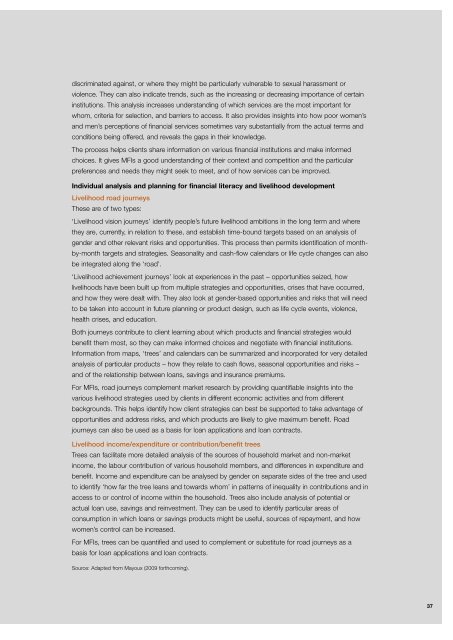Gender and rural microfinance: Reaching and empowering ... - IFAD
Gender and rural microfinance: Reaching and empowering ... - IFAD
Gender and rural microfinance: Reaching and empowering ... - IFAD
Create successful ePaper yourself
Turn your PDF publications into a flip-book with our unique Google optimized e-Paper software.
discriminated against, or where they might be particularly vulnerable to sexual harassment or<br />
violence. They can also indicate trends, such as the increasing or decreasing importance of certain<br />
institutions. This analysis increases underst<strong>and</strong>ing of which services are the most important for<br />
whom, criteria for selection, <strong>and</strong> barriers to access. It also provides insights into how poor women’s<br />
<strong>and</strong> men’s perceptions of financial services sometimes vary substantially from the actual terms <strong>and</strong><br />
conditions being offered, <strong>and</strong> reveals the gaps in their knowledge.<br />
The process helps clients share information on various financial institutions <strong>and</strong> make informed<br />
choices. It gives MFIs a good underst<strong>and</strong>ing of their context <strong>and</strong> competition <strong>and</strong> the particular<br />
preferences <strong>and</strong> needs they might seek to meet, <strong>and</strong> of how services can be improved.<br />
Individual analysis <strong>and</strong> planning for financial literacy <strong>and</strong> livelihood development<br />
Livelihood road journeys<br />
These are of two types:<br />
‘Livelihood vision journeys’ identify people’s future livelihood ambitions in the long term <strong>and</strong> where<br />
they are, currently, in relation to these, <strong>and</strong> establish time-bound targets based on an analysis of<br />
gender <strong>and</strong> other relevant risks <strong>and</strong> opportunities. This process then permits identification of monthby-month<br />
targets <strong>and</strong> strategies. Seasonality <strong>and</strong> cash-flow calendars or life cycle changes can also<br />
be integrated along the ‘road’.<br />
‘Livelihood achievement journeys’ look at experiences in the past – opportunities seized, how<br />
livelihoods have been built up from multiple strategies <strong>and</strong> opportunities, crises that have occurred,<br />
<strong>and</strong> how they were dealt with. They also look at gender-based opportunities <strong>and</strong> risks that will need<br />
to be taken into account in future planning or product design, such as life cycle events, violence,<br />
health crises, <strong>and</strong> education.<br />
Both journeys contribute to client learning about which products <strong>and</strong> financial strategies would<br />
benefit them most, so they can make informed choices <strong>and</strong> negotiate with financial institutions.<br />
Information from maps, ‘trees’ <strong>and</strong> calendars can be summarized <strong>and</strong> incorporated for very detailed<br />
analysis of particular products – how they relate to cash flows, seasonal opportunities <strong>and</strong> risks –<br />
<strong>and</strong> of the relationship between loans, savings <strong>and</strong> insurance premiums.<br />
For MFIs, road journeys complement market research by providing quantifiable insights into the<br />
various livelihood strategies used by clients in different economic activities <strong>and</strong> from different<br />
backgrounds. This helps identify how client strategies can best be supported to take advantage of<br />
opportunities <strong>and</strong> address risks, <strong>and</strong> which products are likely to give maximum benefit. Road<br />
journeys can also be used as a basis for loan applications <strong>and</strong> loan contracts.<br />
Livelihood income/expenditure or contribution/benefit trees<br />
Trees can facilitate more detailed analysis of the sources of household market <strong>and</strong> non-market<br />
income, the labour contribution of various household members, <strong>and</strong> differences in expenditure <strong>and</strong><br />
benefit. Income <strong>and</strong> expenditure can be analysed by gender on separate sides of the tree <strong>and</strong> used<br />
to identify ‘how far the tree leans <strong>and</strong> towards whom’ in patterns of inequality in contributions <strong>and</strong> in<br />
access to or control of income within the household. Trees also include analysis of potential or<br />
actual loan use, savings <strong>and</strong> reinvestment. They can be used to identify particular areas of<br />
consumption in which loans or savings products might be useful, sources of repayment, <strong>and</strong> how<br />
women’s control can be increased.<br />
For MFIs, trees can be quantified <strong>and</strong> used to complement or substitute for road journeys as a<br />
basis for loan applications <strong>and</strong> loan contracts.<br />
Source: Adapted from Mayoux (2009 forthcoming).<br />
37

















